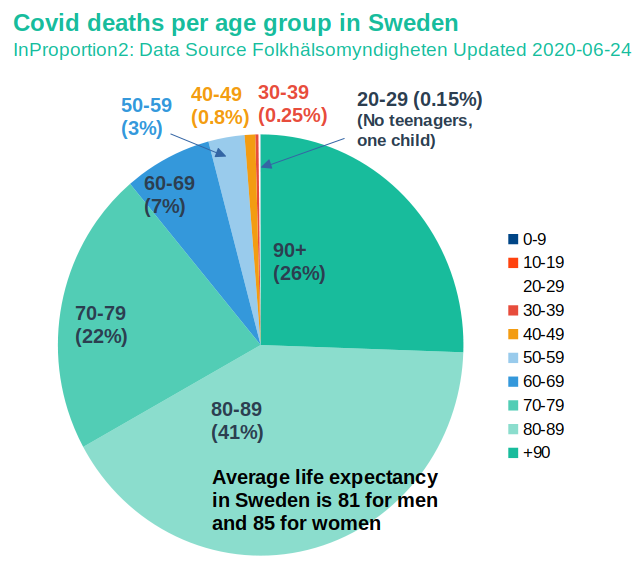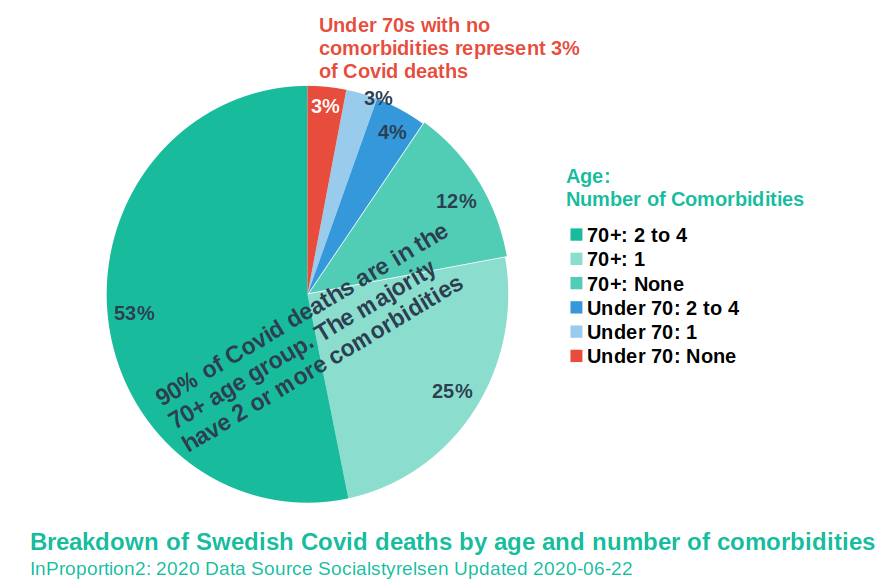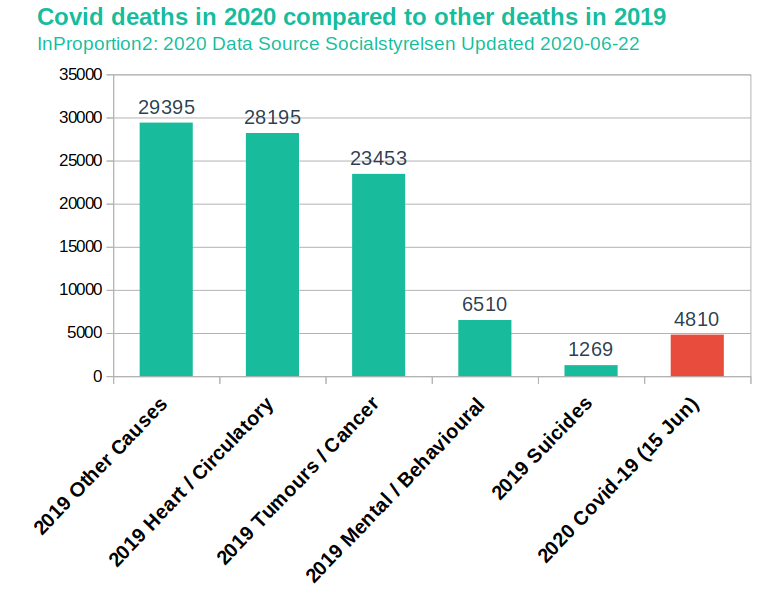In Sweden, over 70s comprise around 90% of Covid-19 deaths, with the majority having two or more comorbidities.
The age group seeing the most Covid fatalities is 80-89 years (41%), followed by the 90+ years category (26%). Note that average life expectancy at birth in Sweden is 81 for men and 85 for women.[2]

85% of Covid deaths linked to at least one comorbidity
Comorbidities are typically cardiovascular disease, high blood pressure, diabetes and respiratory conditions.
Around 85% of people of all ages dying of Covid had at least one other comorbidity:
-
60% of men and 54% of women had two or more reported comorbidities
-
25% of men and 30% of women had one reported comorbidity
-
15% of men and 16% of women had no reported comorbidities

Of total Covid deaths as at 15 June, 468 (just under 10%) were under 70 years of age. Of the under-70 group, 42% had 2-4 comorbidities, 26% had 1 comorbidity, and 32% 0 reported comorbidities. This means that 149 reportedly healthy individuals under 70 died, representing 3% of total deaths.
2019 saw lowest number of deaths for over 40 years
There are approximately 90,000 deaths each year in Sweden. 88,822 people died in 2019 – the lowest number of deaths in a single year since 1977, and 3.3% less than the average over 2016–2018. The Covid-19 outbreak in 2020 may have claimed a larger number of very frail and elderly people than it would have in a different year, due to the previous influenza season being less severe. Indeed, 2018-19 was reported to have been less intense than the five previous flu seasons in Sweden. [1]
Care homes account for half of all Covid fatalities
Of people over 70 who died testing positive for Covid, 52% were in care homes, and a further 27% had home-help services. The corresponding figure for people of all ages is 48% living in care homes, and 26% receiving home-help services [3].
3,000 not unusual toll for a seasonal respiratory virus
It is important to remember that in Sweden as well internationally, viruses other than Covid-19 can be deadly or so serious as to require hospitalization, particularly in the elderly and those in risk groups, but in rare cases even in young people. For example, in the intense influenza season of 2017-18, despite vaccination, Sweden reported 1,021 flu deaths occurring within 30 days of a diagnosis, 93 percent of which were in the age group 65 years and older. During the same season, 447 patients were reported to be in intensive care with influenza. Of these, 15 required oxygen treatment, with 9 of these patients being under the age of 40. Of all intensive care patients, 74 percent belonged to at least one medical risk group or were 65 years of age or older [4].
During each of the influenza epidemics of the 1980s and 1990s, before the influenza vaccine was widely available in Sweden, approximately 3,000 people died, according to Swedish statistician Åke Nilsson. However, Nilsson points out that since then not only has the population grown, but also the number of seniors has increased significantly, with one of the most severely affected groups – the over 90s – having more than doubled in size [5].
Heart conditions and cancer still top the list
In an influenza season it is not uncommon for 1,000-3,000 people to die in Sweden. How does this compare to other causes of death in 2019? Here are the 2020 Covid deaths shown in context with a breakdown of all the 88,822 deaths in 2019.

Also in 2019, 221 people were killed (a decrease from 324 in 2018) and 43,372 injured – 1,244 seriously – in road traffic accidents in Sweden [6].
However, more risky by far than being infected with Covid-19 or taking a car journey is smoking. The Public Health Agency estimates that 12,000 people per year died in Sweden over 2010–2012 as a result of smoking, while around 100,000 per year suffer from smoking-related illnesses [7].
It is indeed important to maintain perspective on the impact of Covid on overall mortality in Sweden, and the risk it represents to the population. If Covid deaths were to amount to around 6,000 this year, and total deaths from all causes 94,000 (as calculated roughly by statistician Åke Nilsson last month), Covid would then account for 6% of all-cause deaths, versus around 30% for heart and circulatory diseases and 25% for cancer. [5]
Summary
Of the 4,810 who died of Covid-19 by mid-June, 90% were over 70 and 82% over 75. In addition, 85% had at least one comorbidity, and 74% were either in care homes or had home help. Only 1% of people dying of Covid in Sweden were under 50. Even in the modern era, it is not unusual for seasonal viruses to claim up to 3,000 lives in Sweden, and any Covid fatalities must be seen in the perspective of other causes of death, for instance cancer and heart disease, which claim a far greater number of lives. This year's final death toll in Sweden will be influenced by demographics and the low number of deaths seen in 2019, which saw a correspondingly mild influenza season.
In Sweden, as globally, Covid-19 has mainly seriously affected very ill, elderly people in care homes. The death toll thus far is significant, but in 2019 over five times more people died of heart conditions, still the number one cause of death in Sweden.
Notes and sources
This data is based mainly on the number of deaths up to and including 15 June 2020 (4,810) from Sweden's National Board of Health and Welfare (Socialstyrelsen), which keeps thorough statistics based on cause-of-death certificates submitted by doctors within three weeks of the time of death (the illness or injury that set in motion the process that culminated in the death is classified as the underlying cause of death. Factors contributing to the death, 'comorbidities', may also be recorded).
These statistics differ slightly from those presented daily by the Swedish Public Health Agency (Folkhälsomyndigheten), which only reports deaths with laboratory-confirmed Covid-19 who have died within 30 days (50 percent of these are reported within 48 hours and about 90 percent within a week). Socialstyrelsen reports all cases where the underlying cause of death was Covid-19, regardless of whether the diagnosis was laboratory-confirmed or not. Of the total number of Covid deaths from Socialstyrelsen, 89 percent (4,261 of 4,810) had lab-confirmed Covid-19 according to Folkhälsomyndigheten's database, which indicates that these two registers show a good correlation [8].
-
[1] Public Health Agency/Folkhälsomyndigheten Influenza Report, 24 September 2019
-
[2]
-
SCB/Statistics Sweden 2019
-
ONS 2016-2018
-
-
[3] Socialstyrelsen, Statistik över antal avlidna i covid-19
-
[4] Folkhälsomyndigheten Influenza Report, 3 October 2018
-
[5] More swedes died in one month 1993 and 2000, compared to April 2020 — why?
-
[8] Socialstyrelsen, Statistik över antal avlidna i covid-19